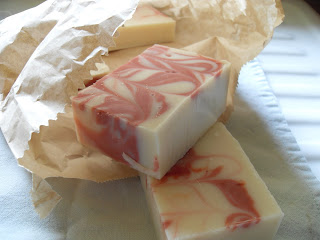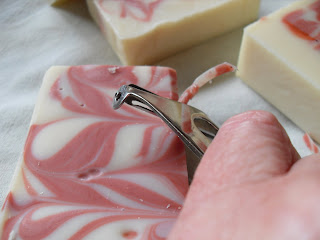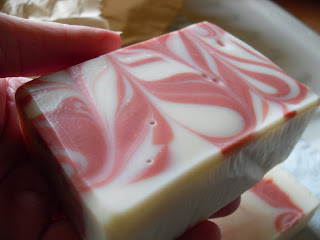I always keep a stash of soap here....
...under the sink in the kitchen. I don't make a dedicated kitchen soap, I tend to use it just for hand washing anyway, so the same stuff that ends up in the shower can be found here.
I keep it in a brown paper bag tightly closed to preserve the scent of the soap. It works very well and these soaps, which have been here for months and months still smell of orange and lavender.
When I ran the soap company I very seldom had complaints about the soap - once when a very ancient old lady whined about the price (she thought £3 a bar was expensive) she compared my soap to Lux and said that it wasn't any different so why was it so expensive. She wasn't convinced by my explanation about the precious oils and the abundance of natural glycerin. But that's all by the way... the main complaint I frequently had, was from men, and it suprised me. They did not like the sharp edges on the soap. Even though I explained that the edges would soon round down with use, they always screwed up their faces and said how awkward it was to use sharp edged soap.
I firmly believe that chamfering the edges of the soap is firstly, a waste of soap and secondly, a waste of your time - but if you want to please the man (men) in your life then perhaps it's worth it.
This is how you do it. It's best to do this once your soap has fully hardened, so after curing for at least 4 weeks. Take a vegetable peeler (a speed peeler as Jamie Oliver calls it) and run it along the sharp edge of the soap.
A thin sliver of soap will come off. Sometimes they come off in great long curls, sometimes they simply shatter into little shards of soap.
You can do all the edges, vertical and horizontal. Then you take a clean dry cloth ( a T towel is good) and polish up the surface of the soap until it shines. You don't believe me when I say the soap will shine? Give it a go and you will see what I mean.
The soap is then ready to be wrapped or displayed for all to see how pretty it is... and how nice to use. And you can be sure that the man in your life won't have to put up with any sharp edges on his delicate skin!
Oh yes, and because I don't believe in wasting anything... all those little shards and curls of soap that peeled off, don't throw them away. Put them in an airtight container and the next time you are making soap, when it gets to trace, chuck them in, give it a stir and then pour into the mould. Sometimes if I had an underweight coloured bar I used to cut it into little cubes and I would add it to a batch of plain soap so that when it turned out it looked like dolly mixtures in the soap. If you use your imagination you could make some really interesting combinations. Just scent the main batch as you would normally (don't worry if the shards of soap are from a scented batch or not, they are too small to affect the smell of the final soap) and then chuck in the little offcuts, stir and pour into your mould.
Labels
- Balms (6)
- Bath (11)
- Chit Chat (6)
- Cleansing (5)
- courses (1)
- Deep Cleansing (3)
- Equipment (1)
- Essential Oils (5)
- Feet (1)
- Haircare (8)
- Herbs (4)
- Historical (1)
- Milk (1)
- Mud Masks (2)
- Oils (8)
- Problem Skin (3)
- Recipes (32)
- Safety (2)
- Soap Making (20)
- Sodium Hydroxide (2)
- Theory (39)
- water (3)
Comments
I LOVE comments, so please, if you have an opinion or would like to ask a question, do so. But do check back as I shall answer any questions in the comments of the relevant post - that way, everyone can benefit from everybody's knowledge and advice.
Friday, 15 April 2011
4 comments:
I am sorry but due to repetitive spam posts in the comments I can no longer accept comments from 'Anonymous' contributors. Replies to any questions in your comments will be posted below so that everyone can benefit from the exchange of knowledge and views. Please check back regularly to follow the conversation. :-)
Subscribe to:
Post Comments (Atom)










How do you make the big blocks? What mold do use?
ReplyDeleteI love the colour, did you just use a food dye?
My first batch should be ready next week - that will be 4 weeks, so I will let know it is.
Sue
I sometimes use an old drawer as a mould - lined with greaseproof paper. Although I think I made these in a cardboard box - again lined with greaseproof paper. The colour is an oxide pigment specifically for soap making - you can't use food colours in cold processed soap, they simply don't work, its because of the caustic soda. I hope your first batch is lovely, I am sure it will be!
ReplyDeleteThank you
ReplyDeleteSue
Your soap's so pretty .
ReplyDeleteMy Grandmother used to buy soap in vast quantities and store it on shelves above the front door into their flat .It then hardened for at least a year , great care being taken to use it all strictly in turn . With ten children , a lot was needed and the hall always smelt lovely .
I don't suppose they worried too much about bevelled edges !